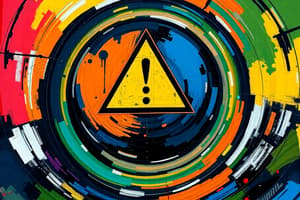Podcast
Questions and Answers
A systematic evaluation of potential hazards and their associated risks is a key component of environmental safety.
A systematic evaluation of potential hazards and their associated risks is a key component of environmental safety.
True (A)
Modifying equipment to reduce hazards is considered an administrative control in environmental safety.
Modifying equipment to reduce hazards is considered an administrative control in environmental safety.
False (B)
Monitoring environmental conditions is crucial for assessing the effectiveness of control measures implemented for environmental safety.
Monitoring environmental conditions is crucial for assessing the effectiveness of control measures implemented for environmental safety.
True (A)
Appropriate disposal of hazardous waste is a critical aspect of infection control.
Appropriate disposal of hazardous waste is a critical aspect of infection control.
Emergency preparedness plans are essential for responding effectively to accidents, spills, or other unforeseen events in both environmental safety and infection control.
Emergency preparedness plans are essential for responding effectively to accidents, spills, or other unforeseen events in both environmental safety and infection control.
The use of alcohol-based hand sanitizers is a crucial practice in standard precautions for infection control.
The use of alcohol-based hand sanitizers is a crucial practice in standard precautions for infection control.
Transmission-based precautions are implemented for all infections, regardless of the known route of transmission.
Transmission-based precautions are implemented for all infections, regardless of the known route of transmission.
The use of personal protective equipment (PPE) such as gloves, gowns, masks, and eye protection is a key aspect of both environmental safety and infection control.
The use of personal protective equipment (PPE) such as gloves, gowns, masks, and eye protection is a key aspect of both environmental safety and infection control.
Compliance with regulations ensures that both environmental safety and infection control practices are aligned with legal requirements.
Compliance with regulations ensures that both environmental safety and infection control practices are aligned with legal requirements.
Infection control practices aim to prevent the spread of infectious agents, but have no impact on healthcare-associated infections (HAIs).
Infection control practices aim to prevent the spread of infectious agents, but have no impact on healthcare-associated infections (HAIs).
The primary focus of isolation techniques is to protect healthy individuals from exposure to the infected persons.
The primary focus of isolation techniques is to protect healthy individuals from exposure to the infected persons.
Cleaning and disinfection are primarily focused on eliminating viruses, whereas bacteria are tackled by waste management practices.
Cleaning and disinfection are primarily focused on eliminating viruses, whereas bacteria are tackled by waste management practices.
The effectiveness of vaccination in preventing workplace-related infections is largely due to the fact that it eliminates the risk of contracting the corresponding disease entirely.
The effectiveness of vaccination in preventing workplace-related infections is largely due to the fact that it eliminates the risk of contracting the corresponding disease entirely.
Regular employee health checks focus solely on identifying individuals who are currently infected with contagious diseases.
Regular employee health checks focus solely on identifying individuals who are currently infected with contagious diseases.
Proper waste management is essential for the prevention of sharps injuries, which pose a high risk of infection transmission.
Proper waste management is essential for the prevention of sharps injuries, which pose a high risk of infection transmission.
The effectiveness of isolation techniques is largely dependent upon strict adherence to established guidelines, regardless of the nature of the infection.
The effectiveness of isolation techniques is largely dependent upon strict adherence to established guidelines, regardless of the nature of the infection.
The use of specialized equipment and procedures in waste management is primarily aimed at reducing the risk of cross-contamination.
The use of specialized equipment and procedures in waste management is primarily aimed at reducing the risk of cross-contamination.
Monitoring of outbreaks is essential for determining the source of infection and implementing appropriate control measures.
Monitoring of outbreaks is essential for determining the source of infection and implementing appropriate control measures.
Vaccination is considered a primary intervention strategy for preventing the spread of infections, while isolation techniques are primarily used for managing existing outbreaks.
Vaccination is considered a primary intervention strategy for preventing the spread of infections, while isolation techniques are primarily used for managing existing outbreaks.
The effectiveness of cleaning and disinfection hinges upon the correct choice and application of cleaning agents, tailored to the specific pathogens present.
The effectiveness of cleaning and disinfection hinges upon the correct choice and application of cleaning agents, tailored to the specific pathogens present.
Flashcards
Cleaning and disinfection
Cleaning and disinfection
The process of thoroughly cleaning surfaces and items to remove pathogens and prevent transmission.
Waste management
Waste management
Proper handling and disposal of contaminated waste to prevent exposure from items like needles.
Employee health and vaccination
Employee health and vaccination
Policies that promote employee health and vaccinations to prevent diseases like hepatitis B.
Isolation techniques
Isolation techniques
Signup and view all the flashcards
Monitoring of outbreaks
Monitoring of outbreaks
Signup and view all the flashcards
Pathogens
Pathogens
Signup and view all the flashcards
Contaminated waste
Contaminated waste
Signup and view all the flashcards
Vaccination policies
Vaccination policies
Signup and view all the flashcards
Surveillance
Surveillance
Signup and view all the flashcards
Infection control
Infection control
Signup and view all the flashcards
Environmental Safety
Environmental Safety
Signup and view all the flashcards
Hazard Identification
Hazard Identification
Signup and view all the flashcards
Control Measures
Control Measures
Signup and view all the flashcards
Monitoring and Surveillance
Monitoring and Surveillance
Signup and view all the flashcards
Emergency Preparedness
Emergency Preparedness
Signup and view all the flashcards
Compliance with Regulations
Compliance with Regulations
Signup and view all the flashcards
Hand Hygiene
Hand Hygiene
Signup and view all the flashcards
Standard Precautions
Standard Precautions
Signup and view all the flashcards
Study Notes
Environmental Safety
- Environmental safety encompasses practices and procedures designed to protect people and the environment from hazards, risks, and pollution.
- Key aspects include:
- Hazard identification and risk assessment: Systematic evaluation of potential hazards and their associated risks to determine the likelihood and severity of adverse effects. This involves identifying potential sources of danger and the probability of their causing harm.
- Control measures: Implementing control strategies to minimize or eliminate hazards. These can involve engineering controls (e.g., modifying equipment), administrative controls (e.g., training, procedures), and personal protective equipment (PPE).
- Monitoring and surveillance: Regular monitoring of environmental conditions and the effectiveness of implemented control measures to detect potential problems and ensure safety.
- Waste management: Proper collection, handling, transportation, and disposal of waste materials to prevent pollution and environmental contamination. This includes understanding classifications and correct disposal methods for various types of hazardous waste.
- Emergency preparedness and response: Developing and practicing emergency plans and procedures to effectively respond to accidents, spills, or other unexpected events. This includes evacuation procedures, first aid, and communication protocols.
- Compliance with regulations: Adherence to local, state, and federal regulations and standards related to environmental safety.
Infection Control
- Infection control measures are practices used to limit the transmission of infectious agents, preventing disease outbreaks and healthcare-associated infections (HAIs)
- Key aspects include:
- Hand hygiene: Frequent and thorough handwashing with soap and water or alcohol-based hand sanitizers, especially before and after patient contact, and after contact with potentially contaminated objects or body fluids.
- Standard precautions: Applying universal precautions to prevent the transmission of bloodborne pathogens and other potentially infectious materials. This includes using appropriate personal protective equipment (PPE) such as gloves, gowns, masks, and eye protection.
- Transmission-based precautions: Implementing additional control measures for specific infections, such as airborne, droplet, or contact precautions, based on the known route of transmission.
- Cleaning and disinfection: Thorough cleaning and disinfection of surfaces, equipment, and other items in the environment to remove pathogens and prevent transmission.
- Waste management: Proper handling and disposal of contaminated waste materials, including sharps (needles, lancets), to prevent accidental exposure.
- Employee health and vaccination: Policies emphasizing employee health and vaccination against easily preventable diseases relevant to the workplace, such as hepatitis B or influenza.
- Isolation techniques: Placing infected individuals in isolation to prevent the spread of the infection to others. This involves strict adherence to the isolation guidelines for patients and staff.
- Monitoring of outbreaks: Continuous surveillance and monitoring to detect and manage any potential infectious disease outbreaks promptly.
Studying That Suits You
Use AI to generate personalized quizzes and flashcards to suit your learning preferences.




